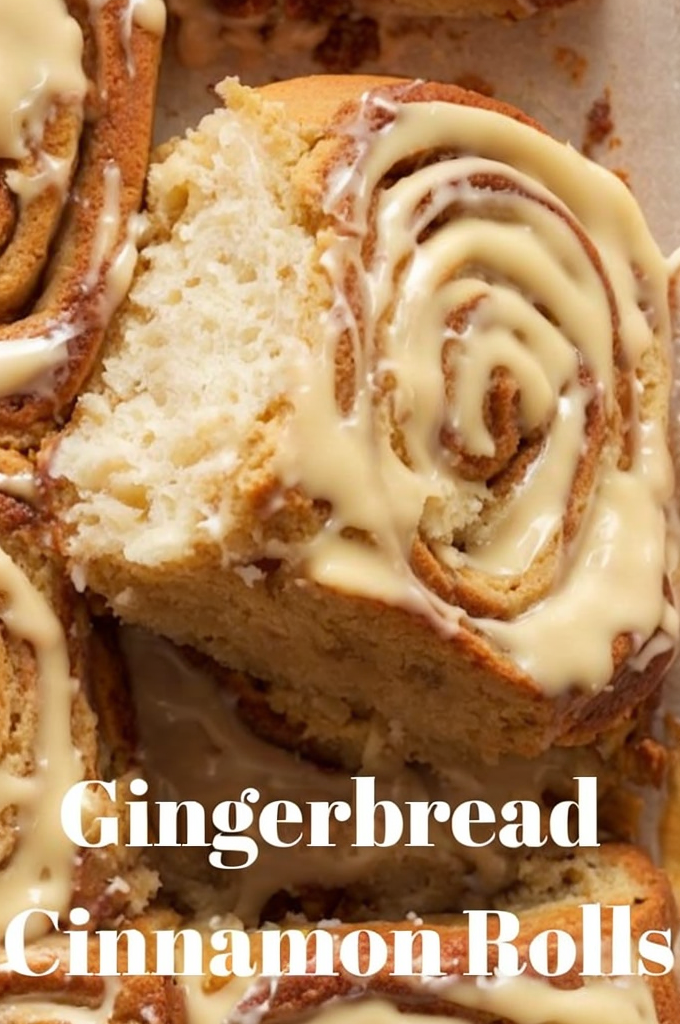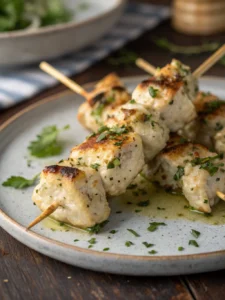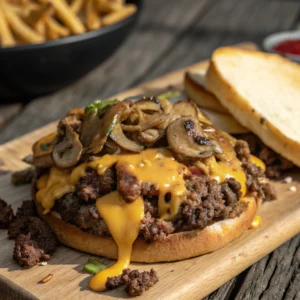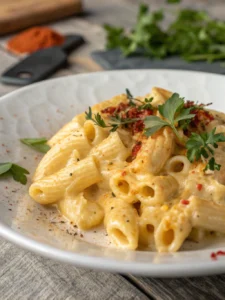Best Christmas Gingerbread Cinnamon Rolls – Family Favorite
The Best Christmas Gingerbread Cinnamon Rolls are here to make your festive season deliciously memorable. Imagine warm, spicy undertones of ginger and cinnamon making your kitchen smell like a winter wonderland. These rolls are a perfect blend of sweet and spice, enveloped in soft, pillowy dough. Whether it’s Christmas morning or a cozy afternoon, these cinnamon rolls promise to fill your heart and home with seasonal joy. Crafted with love and designed for indulgence, these rolls have become a family favorite for good reason.
Combining traditional holiday flavors, the gingerbread cinnamon rolls carry an exquisite balance of spice and sweetness, capturing the essence of Christmas in every bite. The moist, delightful texture alongside rich buttery notes ensures an unforgettable taste experience. Enhanced by a drizzle of sweet icing, these rolls are as pleasing to the eyes as they are to the palate. This recipe is not only centered around impressive flavors but also evokes the warmth and spirit of togetherness that Christmas brings.
Quick Recipe Highlights
- Flavor Profile: Sweet, spicy with a gentle hint of molasses, perfectly embodying Christmas flavors.
- Texture: Soft, fluffy dough that is both tender and moist, creating a melt-in-your-mouth experience.
- Aroma: Infused with the comforting scent of cinnamon and ginger that fills the air, reminiscent of holiday baking.
- Visual Appeal: Golden-brown rolls with a luscious white icing drizzle create a visually stunning centerpiece.
- Skill Level Needed: Medium difficulty, requiring basic baking skills and a good eye for dough rising.
- Special Equipment: Stand mixer with dough hook, rolling pin, and baking dish.
Recipe Overview
- Difficulty Level: These gingerbread cinnamon rolls are classified as medium difficulty due to the yeast dough preparation and rise time, which demands some attention but is manageable with instructions.
- Category: Baked goods, breakfast, dessert.
- Cuisine: Blends European baking techniques with traditional holiday spices, providing a unique fusion of flavor and tradition.
- Cost: Moderate cost, involving standard baking ingredients with some specialty items like molasses and ginger.
- Season: Best enjoyed during winter months, particularly around the holiday season, to match the festive flavors.
- Occasion: Ideal for Christmas morning, holiday brunches, or winter gatherings with friends and family.
Why You’ll Love This Recipe
These Best Christmas Gingerbread Cinnamon Rolls offer an irresistible combination of flavors, bringing together the warmth of cinnamon and ginger with the sweetness of icing. The gentle spice beautifully complements the soft, gooey center of each roll, making them a standout at any festive occasion. Not only are they scrumptious, but they also bring comforting nostalgia and the sensory joy of holiday baking traditions.
Preparation is straightforward with minimal hassle. The dough comes together effortlessly using a stand mixer, while the rest is simply a matter of following standard baking processes. Even beginners will find the clear, step-by-step instructions easy to follow, ensuring a successful turnout that will impress both family and guests alike.
Beyond taste, these gingerbread cinnamon rolls provide nutritional value, with the added benefits of spices like cinnamon, known for its antioxidant properties. Though indulgent, they offer a better-for-you alternative to more processed holiday treats, catering to those seeking both taste and a mindful eating experience.
These cinnamon rolls are perfect for festive gatherings, creating opportunities for social interaction around shared food. Their enticing aroma sets a joyful scene, while their visually appealing presence on the table invites conversation and compliments. Serve with coffee or hot chocolate to enhance the communal holiday feel.
Cost-effectiveness is key, as basic pantry staples and a few special purchases are all that’s required to create this delightful dish. The recipe is flexible enough to adapt to what’s on hand, allowing savvy bakers to keep expenses in check while still delivering on flavor and joy.
Historical Background and Cultural Significance
The history of gingerbread dates back centuries, ingrained deeply in culinary traditions across Europe. Its journey began with recipes influenced by Middle Eastern spices brought to Europe during the Crusades, evolving into an essential part of holiday traditions.
Culturally, gingerbread has become synonymous with Christmas and winter festivities, from cookies to houses, symbolizing warmth and creativity. Over time, bakers have crafted new spins on traditional recipes, transforming classic flavors into novel treats like these gingerbread cinnamon rolls, showcasing cultural evolution and innovation.
The gingerbread roll is an adaptation reflecting geographic tastes and preferences. For instance, while Europeans might favor more heavily spiced or less sweet versions, this recipe balances the preferences of various modern palates, combining a gentle sweetness with robust spices to cater to an international audience.
Regionally, variations in spices and sweetness levels can be observed. Some regions incorporate fruits or fruits’ essence, while others might use alternative sweeteners. This recipe maintains a balance, allowing for personal adaptation without losing its core essence, celebrating universal appeal.
Ingredient Deep Dive
Flour is the foundation of these rolls, providing structure and texture. High-quality all-purpose flour is recommended for achieving the perfect rise without heaviness. Store flour in an airtight container to maintain freshness, and sift before use to avoid lumps and ensure accurate measurements for consistent results.
Cinnamon, the star of our spice blend, is prized for its warming flavor and myriad health benefits, including anti-inflammatory properties. Choose fresh, aromatic cinnamon for maximum flavor impact, storing it in a cool, dark place to preserve potency. Cassia cinnamon is common, though Ceylon offers a subtler alternative.
Ginger brings a zesty, pungent spice to the rolls, contributing to both flavor and culinary heritage. Fresh ginger imparts stronger notes, preferable for those seeking boldness, while ground ginger introduces a more mellow essence. When storing, keep it airtight, away from heat and light, for sustained freshness.
Molasses enrich the dough with deep, complex sweetness and a touch of caramel. Known for its iron content, molasses contributes both flavor and slight nutritional benefits. Unsulphured molasses is ideal for baking, striking the right balance in sweetness and acidity. Refrigeration extends shelf life post-opening.
Common Mistakes to Avoid
- Overproofing the dough: Ensure not to let the dough rise too long, as it could become overly airy and collapse during baking.
- Incorrect flour measurement: Always spoon flour into your measuring cup, avoiding directly scooping from the bag to prevent excess and a dense dough.
- Skipping dough rest: Allowing the dough to rest ensures it remains tender and pliable, facilitating easier rolling.
- Improper spice distribution: Mix spices evenly into the filling to prevent uneven flavors throughout the rolls.
- Inadequate icing coverage: Ensure rolls are slightly cool before icing to maintain the contrast between fluffy rolls and creamy topping.
- Ignoring oven calibration: Verify your oven temperature to prevent undercooked or burnt rolls.
- Skimping on rising time: Allow sufficient time for both rises to guarantee proper fluffiness.
- Improper roll spacing: Leave adequate space between rolls in the pan to allow for even baking and expansion.
Essential Techniques
Kneading the dough is a crucial step in achieving the perfect texture. This technique develops gluten, imperative for the dough’s elasticity and structure. Master kneading by pushing and folding the dough until smooth and elastic, avoiding stickiness which indicates excessive moisture.
Rolling and cutting are instrumental in attaining uniformity in size and bake. Roll dough evenly using steady pressure to maintain shape. For precise results, use a sharp knife or dental floss to cut rolls cleanly without squishing the dough spiral.
Proving dough requires patience. Ensure your dough rises in a warm, draft-free environment, doubling in size without overproofing. Mastering this involves observing the dough, pressing lightly to check for springiness, indicating readiness without rapid deflation.
Icing application is best done with slightly cooled rolls, allowing the icing to set beautifully on top. Use a gentle drizzle motion for even coverage, accentuating the rolls’ spirals. Select a subtle icing, not overpowering the gingerbread’s intrinsic flavor.
Pro Tips for Perfect Best Christmas Gingerbread Cinnamon Rolls
– Ensure all ingredients are at room temperature for even mixing and better dough texture.
– Add a bit of orange zest to the filling for a vibrant twist enhancing gingerbread flavors.
– Use a thermometer to assess water temperature when proofing yeast, ensuring it activates and doesn’t scald.
– Brush rolls with butter before baking for a golden finish and depth of flavor.
– Cover the rolls if necessary halfway through baking to prevent excessive browning.
– Utilize a glass or metal baking dish to encourage even cooking and desired crust texture.
– Consider letting rolls sit for a few minutes when out of the oven for firmer handling before icing.
Variations and Adaptations
Enrich the traditional flavor by incorporating a touch of nutmeg or allspice for additional warmth and complexity, catering to personal tastes and spice preferences. Seasonal adaptations like pumpkin spice can be mixed into the filling, introducing an autumnal note fitting for Halloween or Thanksgiving.
For dietary needs, implement adjustments like using gluten-free flour blends and ensuring all other ingredients are compatible, maintaining roll integrity and taste. Vegan adaptations such as plant-based butter and milk substitutes achieve similar moisture and texture profiles without animal products.
Consider using various sweeteners like honey or maple syrup for molasses, adjusting related spices to balance sweetness. Flavor can also be varied by integrating nuts or raisins, offering a contrast in texture and sweetness, elevating the flavor experience.
Bake rolls in muffin tins for individual servings, which not only appears playful but provides simpler portion control. This adaptation is perfect for parties or single servings, ensuring each piece maintains its shape and presentation, facilitating an easy grab-and-go option.
Serving and Presentation Guide
Present rolls in a round arrangement on decorative platters, emphasizing their delightful spirals. To accentuate their visual appeal, drape generous icing with additional cinnamon dusting, creating an inviting treat that tempts both eyes and tastebuds.
Garnish with slivers of candied ginger or fresh berries, adding color and and extra zing. Such embellishments introduce an element of surprise and conviviality to traditional presentation, inviting comments and appreciation from guests appreciating thoughtful touches.
Pair rolls with hot beverages like spiced apple cider or a comforting chai to complement their warming, spicy notes. Coffee, with its robust and contrasting bitterness, equally enhances the sweet and spiced flavor profiles, creating an ideal match for a sophisticated brunch menu.
Maintain rolls fresh by serving at just above room temperature, preserving icing integrity while encouraging soft centers. For more formal settings, consider pre-slicing rolls to promote ease of serving and neatness. Offer extra icing on the side for custom drizzling, appealing to indulgent sensibilities.
Wine and Beverage Pairing
Pair with a light dessert wine, like a sweet Riesling or Muscat, which complements the spiciness without overwhelming. These choices balance sweetness with acidity, ensuring the rolls remain the centerpiece without cloying palate.
Non-alcoholic options such as hot mulled cider or spiced tea further complete the warming experience of gingerbread rolls. These drinks accentuate the spices without dominating the rolls’ intrinsic flavors, combining comfort and familiarity.
Consider coffee for a robust pairing with complex notes ending in a satisfying aftertaste. Opt for medium roast or flavored varieties aligning flavors, ensuring a harmonized tasting experience.
For serving, strive to match serving temperatures between rolls and beverages, introducing a complimentary warmth throughout. Provide well-matched cups or glasses to maintain consistent aesthetic appeal, whether in an intimate gathering or larger festive celebration.
Storage and Shelf Life
To store, keep rolls in an airtight container at room temperature for up to two days. Refrigeration can extend shelf life to five days, though slightly hardening, so consider reheating briefly for softening and enhancing aroma.
For longer storage, freeze rolls individually or collectively, ensuring proper wrap in plastic or foil before placing in a freezer-safe bag. Maintain moisture and prevent freezer burn by removing air, ensuring flavor and consistency upon thawing and reheating.
Recognize spoilage through stale textures or unexpected sour scents. To reheat, microwave briefly or warm in an oven, steered with foil cover for even heating and texture preservation, ensuring rolls remain appetizing and fresh-tasting.
Make Ahead Strategies
This recipe accommodates planning with make-ahead steps, aligning with festive schedules needing early preparation. Mix dough, refrigerating overnight to save time, allowing flavors to meld and improve while chilling.
During preparation pauses, store semi-prepared rolls within cold environments to consolidate efforts without compromising results. Crucially testing encounters diminished rising effects, confirming outcomes still deliver expected fluffiness and tenderness post-cooling breaks.
Complete steps until final rise, then refrigerate rolls, pinning convenience into festive preparations. Cover tightly to prevent drying while promoting ease upon removal and scheduled reheating, invigorating fluffy freshness.
Scaling Instructions
For smaller portions, halve ingredient quantities, noting small effects possibly requiring slight adjustments in baking times or pan sizes for comparable outcomes. Confirm roll spacing and lighting adjustments to yield expected results without addition of excess moisture or dough adjustments.
To expand for large gatherings, proportionally increase ingredients, ensuring equipment suits additional quantities. Utilize larger baking dishes or multiple trays to distribute rolls evenly, promoting consistent rising and browning during extended baking times.
Monitor cooking times closely, with extended batches requiring uniformity checks. Store completed rolls proportionally for anticipated servings, capitalizing on spice-rich bursting rolls while encouraging consistent tasting experience.
Nutritional Deep Dive
These gingerbread cinnamon rolls offer a delicious balance of macronutrients, with the primary components stemming from carbohydrates in flour and sugars, complimented by butter and milk providing necessary fats for tenderness and richness.
Micronutrients like calcium augment the rolls from milk, achieving supportive bone health while cinnamon introduces trace nutrients and advantages such as improved insulin sensitivity in a balanced diet. Concentrate on moderation for tasting indulgence, especially to align with dietary allowances.
Consider smaller portion sizes to appreciate flavors responsibly, encouraging gradual tasting enjoyment while focusing on maintaining alignment with broader health goals. For those interested in caloric impact management, additional investigative exchanges on selective item substitutions assist in personal modifications.
Dietary Adaptations
Create gluten-free versions by using specialty flour blends, adhering to instruction consistency alongside xanthan gum for dough structure. Acknowledge slight variance in texture, retaining core flavors with adjustments suited to dietary needs.
Dairy-free options integrate plant-derived alternatives, substituting milk and butter with almond or coconut variants for similar moisture and richness. Practitioners note nuanced taste adaptations, enhancing versatility and adherence without direct dairy involvement.
Vegan rolls omit eggs, supplemented by flaxseed or alternative binders ensuring texture uniformity without sacrificing delight or experiencing dry deficiencies, recognizing valuable adaptation without eggs’ traditional role.
Low-carb enthusiasts may engage almond flour replacements or alternative sweeteners supplementing molasses naturally, transposing influential flavor while engaging texture adaptational elements crucial for satisfaction.
Explore additional dietary modifications within personalized contexts, establishing a sense of culinary freedom, seamless societal integration with inclusive gingerbread cinnamon rolls assembled for all admiration and enjoyment, regardless of dietary practices.
The Recipe
Gingerbread Cinnamon Rolls
Serves: 12 rolls
Prep Time: 45 mins
Cook Time: 25 mins
Total Time: 70 mins
Kitchen Equipment Needed
- Stand mixer with dough hook
- Rolling pin
- Baking dish
- Measuring cups and spoons
- Small saucepan
- Spoon or spatula for mixing
Ingredients
- 3 1/4 cups all-purpose flour
- 1/4 cup granulated sugar
- 2 1/4 tsp instant yeast
- 1 tsp salt
- 1 tsp ground cinnamon
- 1/2 tsp ground ginger
- 1/4 cup melted butter
- 1/2 cup molasses
- 3/4 cup milk, warmed
- 1 egg
- 1/4 cup butter, softened (for filling)
- 1/4 cup brown sugar (for filling)
- 1 tsp ground cinnamon (for filling)
Directions
- In a stand mixer bowl, combine flour, sugar, yeast, salt, cinnamon, and ginger. Mix briefly to combine.
- Add melted butter, molasses, warm milk, and egg. Mix on medium speed with a dough hook until a smooth dough forms, about 5-7 minutes.
- Transfer dough to a greased bowl, cover, and allow to rise in a warm spot until doubled in size, about 1 hour.
- Roll dough on a floured surface into a 16×12 inch rectangle. Spread softened butter over the dough, leaving a 1/2 inch border.
- Sprinkle brown sugar and additional cinnamon evenly over buttered dough.
- Tightly roll up the dough starting from the longer side, then slice into 12 even pieces.
- Arrange rolls in a greased baking dish. Cover and let rise until nearly doubled, about 30 minutes.
- Preheat oven to 350°F (175°C). Bake rolls until golden brown, about 25 minutes. Cool slightly before icing (if desired).
Recipe Notes
- If desired, drizzle icing made from powdered sugar and milk over slightly cooled rolls for added sweetness.
- Consider adjusting spices to personal taste or include nutmeg for additional warmth.
Troubleshooting Guide
Address texture issues by ensuring proper rise times, with dough achieving optimal elasticity and not over- or under-kneading to retain desired softness. If dough feels dry, consider slight milk additions when mixing to reintroduce necessary moisture.
Balance flavors by adjusting cinnamon and ginger ratios according to individual complexities and spice tolerance, maintaining harmony with base sugar levels to prevent overwhelming palates. Utilize taste tests for fine-tuning during preparation.
Correct temperature challenges by verifying oven accuracy, occasionally rotating rolls for uniformity and ensuring preheat processes are observed to standard times. Use natural thermometer indicators or guide lights for standard-cross checks.
Navigate equipment setbacks by substitution trials within semantically aligned kitchen tools and verified integrity of dough hook operations or baking dish sizes, thus ensuring adjusted alignments compensating accurately for any disparities.
Overcome ingredient substitutions by testing impacts with smaller product opportunities grouped bigger-quantity spins for intuitive proactivity in evaluation along consistently observed and necessity-prone adaptations, based similarly aligned recipes meanwhile.
Recipe Success Stories
Through shared experiences, community members have reported varying adaptations with delightful outcomes. One reader creatively integrated candied fruits, producing a delightful variation appreciated universally at a family brunch.
Numerous readers praised the accessible instructions facilitating ease, while visual appeal was notably celebrated. Suggestions included experimenting with icing flavors, some discovering vanilla extract additions elevated their rolls.
Photography tips revealed capturing rolls amidst crafting environments with festive decor enhances their striking appearance. Readers exchange success stories, offering insights and straightforward adaptations to inspire others.
Engagement from baking newcomers showcases instructional confidence, aligning mutual appreciation for culinary exploration with insights into creation, generating recipe-based conversation extending well beyond simple ingredient lists.
Frequently Asked Questions
Can I make the dough without a stand mixer? Yes, you can knead the dough by hand, though it may take a bit longer to achieve the correct texture. Ensure you knead it until it is smooth and elastic.
What can I substitute for molasses? You can use dark corn syrup or maple syrup, though they may alter the flavor slightly. Molasses provides a distinctive taste that aligns closely with traditional gingerbread flavors.
Can the rolls be frozen? Yes, freeze the unbaked rolls after shaping. Allow them to come to room temperature and rise before baking when needed or pre-bake and freeze for longer storage, reheating as desired.
What if my yeast doesn’t foam? Ensure your yeast is fresh and the liquid is the correct temperature, between 95-105°F (35-40°C). If in doubt, start over with fresh yeast to prevent dense rolls.
How can I speed up dough rising? Create a warm environment by placing the covered bowl in an oven set to the lowest setting, then turning it off, or near a gentle heat source to expedite rising.
Is there a way to make them less sweet? Reduce the sugar in the dough slightly or adjust icing application based on preference. Balance spice ratios to maintain inherent taste elements.



